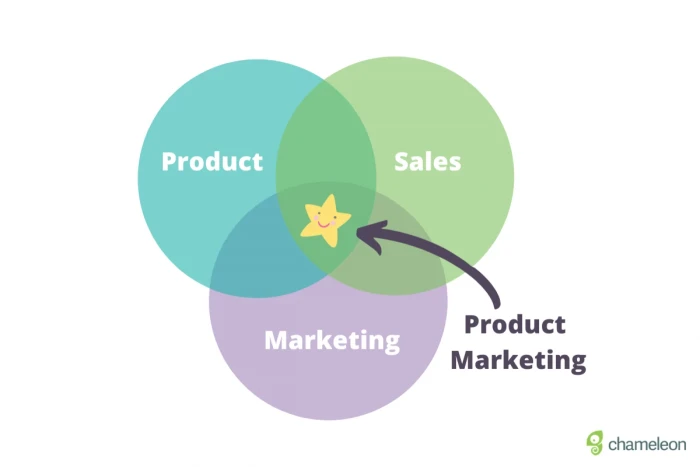It’s time to talk about product marketing teams and how to structure them. Of course, there is no one-size-fits-all solution, we won’t wait until the end of the article to reveal that. However, we see common solutions emerging, depending on the type of company culture, team size, and growth goals that you have at your SaaS org.
This article will outline a few ideal product marketing team structures to give you a better idea of how to structure your own. We’ll also look at:
👩💻 What a product marketing team does: their roles and responsibilities
🏗 Structuring your team: building startup / agile teams
🪴 How to build and grow a cross-functional team
You'll walk away from this article with a solid idea of a product marketing team structure that perfectly aligns with your mission, vision, and product growth goals. And to give you insider tips, we tapped the minds of Product Marketing experts and have peppered their input throughout. A huge thank you to Andrea Saez, Fiona Finn, and Jason Oakley for your time!
Product marketing is a complex combination of product management and marketing tactics to help better sell SaaS products to end-users. Product marketing focuses specifically on:
Product messaging and unique selling propositions (USPs)
Target markets and go-to-market strategies
Product engagements and growth
Revenue retention
Product marketing generates ‘hot’, well-informed leads to make sales easier, quicker, and with a longer shelf life.
To help you understand better, here's a nifty little diagram to summarize what product marketing is:

Read up more on the role in our guide: What is Product Marketing? A Data-Backed Definition.
What does a product marketing team do?
Product marketing teams are responsible for product sales success and the overall product marketing strategy. This means an agile, cross-functional team can be responsible for:
Product launch marketing: Product marketers are essential for product launches. They build hype around a product during pre-product launch, build pre-sales launch mailing lists, take care of website updates, and ensure product understanding among ICPs. Then post-launch they maintain traction around a product, retain users (user retention), and uphold PR initiatives.
Go-to-market strategy: strategizing and enabling your marketing campaigns to ensure they get to your target market effectively and cost-efficiently.
Sales enablement materials: product marketing teams are also responsible for aiding the flow beyond lead generation efforts. This means they enable sales teams with sales collateral, knowing what content leads have already consumed and helping to close deals even quicker.
Content marketing: like most marketing teams a product marketing team is often responsible for the content marketing of your SaaS. They ensure the content you create stays on key topics, keywords, and hits queries or terms that are more likely to be sought out by your ICP. Product marketing teams tend to bring a customer focus to your content creation built from real user data, they eliminate gut feelings and build content from product data.
Target audience research: crucial in ensuring you find product-market-fit, relevant marketing avenues, and run effective marketing campaigns (demand gen and demand capture)
Content partnerships: highly effective strategies for reaching new audiences, or re-engaging with your current audience. The research found that 71% of consumers enjoy co-branding partnerships. We’re starting to see larger co-marketing initiatives—little and large—spread throughout the B2B and B2C world. From Balenciaga and Gucci’s: The Hacker Project to SaaS co-hosted webinars, like the one we recently held with Maze 👇
The list doesn’t stop there. A few more areas a product marketing team is often responsible for, depending on the company size, include:
Market research
User research
Ideal Customer Profiles (ICPs) & User / Buyer Personas
Brand awareness initiatives
Marketing analytics & reporting
Lead generation
Implementing growth tactics
Community management

An overview of product marketing teams' responsibilities from our recent survey
We can certainly agree that product marketing teams have a lot of roles and responsibilities within a thriving SaaS. So, how on earth can you start to narrow down all of these responsibilities to people and keep an agile team structure? Read on.
What does a product marketing team structure in successful SaaS companies look like?
So, let's pop the hood and take a look at what a successful product marketing team looks like.
Team roles
First up, let's cover the typical roles you'll find within a product marketing team and what responsibilities each of these roles has.
Product Marketing Manager: leads the team and communicates the why, what, and when of the product to their team and their customers. Creates and helps to execute the PM strategy.
Content Manager: heads up all content initiatives and strategies. This includes blogs, videos, podcasts, social media, email marketing, website content, and more.
Partnerships Manager: maintains strategic partnerships with brands and influencers. Responsible for the audience reach of launch campaigns, brand awareness, and brand alignment campaigns.
Growth Lead: analyzes and identifies growth opportunities at every stage in the customer journey map. This includes optimizing micro-conversions, customer onboarding completion rates, and more.
Researcher/Data Analysts: supports all PM initiatives ensuring they’re delivered with actionable data. Often responsible for market intelligence, product data, customer interviews, case studies /customer success story research, and more.
Marketing Strategist: supports GTM strategies, initiates campaigns, reports on success, and more.
Of course, a SaaS product marketing team is going to look very different depending on a few things. The size and culture of your product marketing organization will depend on:
Whether your SaaS is Sales-led or product-led
Your marketing budget
Your marketing strategy
Your product learning curve
Your product development stage
Your product niche
Team size
Tomasz Tunguz, venture capitalist and entrepreneur, conducted research on this topic and found that SaaS company’s marketing team size often looks something like the following:
0-1M ARR: 1 person
1-5M ARR: 3 people
5-20M ARR: 6 people
50-100M ARR: 12 people
Tiny teams, right? Especially when you compare it to the growth of some of the other teams Tomasz looked at, marketing was by far the smallest. This begs the question, were these marketing teams, or product marketing teams?
The clue is in the sales teams’ size compared to the marketing teams. Take a look:
1 Marketing person = 2 Salespeople
3 Marketing people = 6 Salespeople
6 Marketing people = 16 Salespeople
12 Marketing people = 41 Salespeople
Having a sales team that dwarfs the marketing team is a sign that you're relying on sales-led growth. Which then leads to the question of: how realistic is growth if you’re still relying on people-power to sell your product? If your product can sell your product, and you’re able to automate your marketing and sales flows, then why wouldn’t you? Your profit margins will be higher, your reach and possibilities for growth will also be much wider. This is why so many SaaS businesses are now focusing on product-led growth. It builds more scalable methods of revenue generation and retention.
We spoke with Andrea Saez, Senior Product Marketing Manager at airfocus, to understand how her product marketing team is structured and who product marketing report to:
"Product Marketing sits with Product at our company. The product team is made up of:
3 PMs: 2 Senior, 1 Junior
1 Technical PM
2 Designers: 1 Senior, 1 Junior
2 PMMs: 1 Senior, and 1 Junior
and, of course, our CPO
So Product Marketing doesn’t sit with Marketing, we sit directly within Product, and we are part of the entire product development process from discovery to launch."
In other words, one answer to the question of size is that for you to add dedicated product marketing capacity to your teams, it would be better to add one or two product marketing managers to your existing product teams and expand from there.
How product marketing teams should be built
On the subject of nuance in how product marketing fits within an organizational structure, let's dig into that a bit more.
Fiona Finn, Director of Product Marketing at Unbounce, noted how PMMs don’t need to belong to Product or Marketing teams:
“At Unbounce, Product Marketing does not sit within Marketing or Product – but in a separate department called Strategic Growth (alongside Customer Marketing and Partnerships).
This allows us to be great partners with our Marketing and Product counterparts, but creates enough autonomy for us to focus on strategy as opposed to tactics or delivery, and gives us more flexibility to work with Product from ideation, to post-launch and adoption. It also allows us to lead other strategic projects with autonomy, and our own budget and timelines.
The goal of our team is to create a team of both specialists and generalists. Every PMM is skilled at the fundamentals of go-to-market strategy (generalist skills), with each PMM having a specialist lens; from monetization to developer marketing, marketplace design, competitor intel, experimentation, and more. These stay fluid based on portfolio needs and professional development plans.”
We also spoke with Jason Oakley, Senior Director of Product Marketing at Klue. Jason shared how their product marketing team is structured.
“We're just starting our product marketing management function from scratch at Klue. That said, I've been lucky to fill two key roles in my first two weeks. Those two roles are Customer/Advocacy Marketing and Competitive Enablement.
Our Customer Marketing Manager focuses on customer stories, reviews, our advisory panel, and other forms of advocacy. She’ll also be focused on marketing to our customers to help drive adoption, engagement, and best practices.
Our Competitive Enablement Manager will own the competitive enablement program at Klue. They will use our own platform (Klue) to develop, maintain, and distribute competitive insights and content to our sales, CS, and product teams to increase competitive confidence and maximize our win rates. They'll also provide support on competitive deals, help train new reps, and evangelize CE across the org and broader market.”
There are a few marketing roles here that we hadn’t mentioned in our previous list. These roles are more niche to the product and team structure. They’re definitely something to consider when building a marketing team.
Hopefully, now you have a fuller picture of the type of team you need to bring your product to success. However, where do you start?
👀 For more product marketing manager tips, take a look at this article
How to build a Product Marketing team from scratch
First things first, you’ll need to assess where you’re at right now. If you don’t have any product marketing hires, then you’ve got a fresh slate. That starts with figuring out some questions first.
Questions to ask before building product marketing functions
What’s your expected/needed SaaS growth rate?
What’s your SaaS company’s product maturity stage?
Do you have a go-to-market strategy already?
Do you have a product launch you’re gearing up for?
What are your immediate & long-term goals?
Depending on how you answer these questions, you should get a clearer idea of the roles you need on-side now and those that can be pushed back or deprioritized.
Andrea from airfocus shared her thoughts on building a marketing team from scratch:
“My advice would be to sit Product Marketing with a Product team! Many people still don’t understand what Product Marketing is, what a PMM does, and how it works, so they tend to place the role as a marketing role. It really isn’t. Marketing is only half of it.
If you want your PMMs to really understand how and why things work the way they do, involve them in the product process from the start. They are part of the discovery process, and in order to define Product-Market-Fit and GTM strategies, they can’t be removed from that process.”
Jason, at Klue, shared his experience of building a product marketing team from scratch as well. He said:
"I've had so much success hiring internally. There are many areas and skills within product marketing that you can teach, but an in-depth understanding of the product and customer is such an advantage when you're trying to hit the ground running. I've had success hiring PMMs from sales, CS, and other teams in marketing. I, myself, was a CSM before I started in product marketing."
Fiona from Unbounce added that when building the product marketing team it’s essential to align internal stakeholders on the value-add of the role as soon as possible:
“Stakeholder management and buy-in can quickly be the biggest blocker to success for forming teams. While you’ll still need to define and explain the scope of PMM at your organization - your focuses, skills, and priorities – get some quick wins down that deliver unique value e.g a pricing project to quickly gain trust and get your seat at the table.”
Key learnings when building a product marketing team from scratch
Prioritize your hires depending on where your business is at and where it’s going
Place your product marketing team within your product department
Don’t rule out internal hires from other departments if you need to hire fast
Who to hire next for your product marketing team?
Fantastic, so you’ve got an idea of who you need to hire right now. Besides your product marketing manager, a few roles will emerge that are an absolute must-have.
Next, you can start looking at hires that can help those lower priority, non-business-critical goals. Although, these hires will still help your product and business thrive. Consider more generic marketing roles and aids like:
Growth managers
Social media managers
PPC specialists
Affiliate/partnership roles
Copywriters
Graphic designers
Community managers
What’s good to keep in mind for these roles is a lot of them can be hired on a freelance basis in the beginning. As long as you’ve got a foundation team in-house to manage strategy and uphold product culture, then the actual implementation of your plans can be outsourced.
It might also be of help to use some sort of resource management software to help you plan for a wider team and manage resources at your disposal.
Closing thoughts on product marketing teams structures
We’ll close out with some final advice from our two contributors for this article.
We asked; what would the ideal product marketing team structure look like for a B2B SaaS company? Andrea said:
“I can’t stress enough how important it is that the product marketing team should be part of the product team. To expand on this, this doesn’t mean they can’t also be part of the marketing team’s meetings. They should be, of course, but their core team should be the product team.
I often describe myself as having gone into Product Marketing instead of continuing with Product because ”I like to talk a lot” – which is, in part, true. But you cannot say someone is in product marketing without them truly understanding how discovery, user research, and experimentation work. It’s such an integral part of what PMMs do, and that’s in direct collaboration with the product team.”
Jason Oakley also added his input:
“It really depends on the company, its product mix, how the product/dev teams are structured, how many personas you have, and how many industries or verticals you play in. I've worked in Product Marketing teams that are structured by product types — each PMM owning their own product line. This works well in a multi-product company.
I've also worked on Product Marketing teams that are divided into specific PMM functions, like customer marketing, sales enablement, positioning, and messaging. This worked well in companies that have one product or platform.
I think, at Klue, I'll be landing somewhere in the middle. We'll have team members specializing in specific areas of product marketing while also bringing on some PMMs to own go-to-market for specific areas of our product.”
And Fiona Finn stressed the importance of research to gain a deep understanding of the customer experience:
“One key element I really think needs to be incorporated into the team is the research arm. While UX may 'own' research internally, there’s an opportunity to build that partnership and further define the scope of a PMM’s responsibility for market research, allowing UX to own customer research and solution delivery.
PMMs should be experts in quantitative and qualitative analysis, primary research methodologies, and data storytelling – partnering with UX for their invaluable expertise so all your research and strategy align.”
Let's hear how product leaders view product marketing within the overall product team structure.
Like we said at the beginning, there's no one-size-fits-all solution for building a product marketing team. Sorry, we had to say it. However, you should now have a much clearer goal of potential marketing roles, team size, and types of hires your SaaS needs right now and in the future.
Want new product marketing content, weekly?
Sign up to our mailing list to get exclusive insights and reads from the product world




